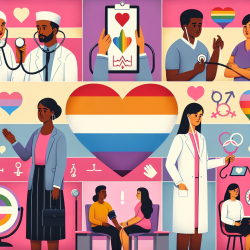Introduction
In the ever-evolving landscape of medical education, innovative approaches to teaching and learning are essential. The research article "The benefits of undergraduate medical students delivering free preparticipation physical evaluations in collaboration with a K-12 school district" highlights a novel approach to medical education that not only enhances student learning but also benefits the community. This blog explores how practitioners can leverage the outcomes of this research to improve their skills and encourages further exploration in this field.
The Power of Student-Run Free Clinics
Student-run free clinics (SRFCs) provide medical students with invaluable opportunities to apply their knowledge in real-world settings. The research conducted by Cappetto et al. demonstrates that participating in SRFCs significantly boosts medical students' confidence in clinical skills, particularly when working with pediatric populations. This experience not only enhances their ability to perform standard physical exams but also improves their communication skills and interdisciplinary collaboration.
Building Confidence and Community Connection
One of the key findings of the study is the increase in students' feelings of connectedness to their original motivations for practicing medicine and to the local community. This connection is crucial in combating the mental health challenges prevalent among medical students, such as depression and burnout. By engaging with the community, students find renewed purpose and motivation, which can be protective against these issues.
Implementing Research Outcomes
For practitioners looking to enhance their skills, the outcomes of this research offer several pathways:
- Engage with Local Schools: Collaborate with local K-12 school districts to organize free preparticipation physical evaluations. This not only benefits students but also fills a critical need within the community.
- Foster Interdisciplinary Learning: Encourage interdisciplinary collaboration during these clinics to enhance communication skills and teamwork.
- Focus on Pediatric Care: Given the limited exposure to pediatric care in many SRFCs, emphasize this area to broaden students' clinical skills.
Encouraging Further Research
The research by Cappetto et al. is a stepping stone for further exploration. Future studies could focus on:
- Longitudinal Impact: Investigate the long-term effects of SRFC participation on students' career choices and mental health.
- Community Feedback: Collect feedback from community members to assess the broader impact of these clinics.
- Curricular Integration: Explore ways to integrate SRFC experiences into medical curricula to maximize educational benefits.
Conclusion
Student-run free clinics represent a powerful model for medical education, offering benefits that extend beyond the classroom. By implementing the outcomes of this research, practitioners can enhance their skills, support student wellness, and strengthen community ties. To read the original research paper, please follow this link: The benefits of undergraduate medical students delivering free preparticipation physical evaluations in collaboration with a K-12 school district.










